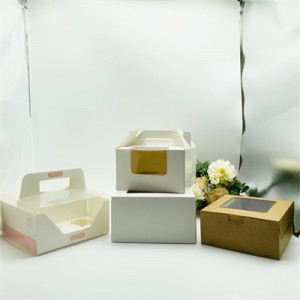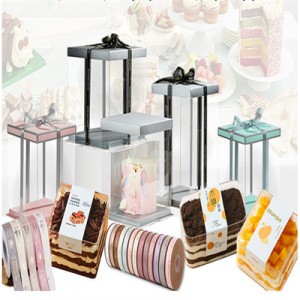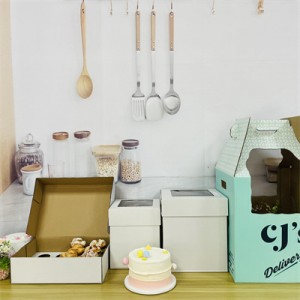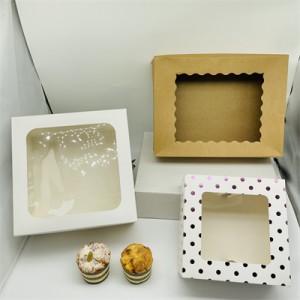Sunshine Bakery Packaging Co., Ltd ( www.cake-board.com )As a manufacturer with 10 years of production of baking packaging products, we are well aware that the packaging selection of baking products has a crucial impact on product quality and sales. In this article, we will explore the factors that affect the packaging selection of baking products from multiple perspectives.
1.Product Type: Matching Packaging to Different Baking Product Requirements
Product Type: Different types of baking products may require different types of packaging. For example, bread may require bags with good sealing and moisture retention, while cakes may require boxes with good protection and display.
2.Preserving Freshness and Taste: Packaging Considerations for Baking Products
Preservation requirements: Baking products usually need to be stored under preservation conditions. Therefore, packaging selection should effectively maintain the freshness and taste of the product. This may require selecting packaging materials with characteristics such as moisture retention, sealing, and oxidation resistance.
3.Durability and Protection: Ensuring Safe Transportation and Handling of Baked Goods
Packaging durability: Baked products may need to withstand certain impacts and pressures during transportation and handling. Therefore, packaging selection should consider the fragility of the product and choose materials with sufficient strength and durability to protect the product from damage.
4.Visual Appeal and Display: Showcasing Baking Products with Effective Packaging
Visibility and display: Baking products are usually sold in a visually appealing manner. Therefore, packaging selection should be able to showcase the appearance and attractiveness of the product, in order to attract consumers' attention.
5.Regulatory Compliance: Meeting Food Safety Standards in Packaging Selection
Regulatory and safety requirements: When selecting packaging, relevant regulations and standards must be followed to ensure that packaging materials are harmless to food safety. This may include selecting packaging that meets the certification standards for food contact materials.
6.Sustainability and Environmental Impact: Choosing Eco-Friendly Packaging Materials
Sustainability considerations: More and more consumers are paying attention to sustainability and environmental protection issues. Therefore, packaging selection should consider using recyclable, reusable, or degradable materials to reduce their impact on the environment.
7.Cost-Effectiveness: Balancing Packaging Costs and Benefits
Cost and benefit: Packaging selection also needs to consider cost factors. Different types of packaging materials and designs can have an impact on costs, so it is necessary to balance costs and benefits.
8.Packaging Size and Capacity: Customizing Packaging for Efficient Storage and Transportation
Packaging capacity and size: The selection of packaging should consider the size and weight of the product to ensure that the packaging can accommodate and adapt to the requirements of the product. At the same time, the size of the packaging also affects the efficiency of storage and transportation.
9.Branding and Design: Creating Packaging that Reflects the Product and Builds Brand Recognition
Packaging design and brand recognition: Packaging can be used as an important element of brand recognition. Therefore, packaging selection should be consistent with the brand image and market positioning of the product, and adopt a design and identification that conforms to the brand style.
10.User-Friendly Packaging: Convenience and Practicality for Consumers
Packaging convenience and usability: Packaging that is easy to open, close, and use is important for consumers. Easy to open zipper bags, easy to split pastry boxes, or easy to reseal packaging can improve product convenience and user experience.
11.Batch and Date Identification: Clear Product Information on Baking Product Packaging
Batch and date identification: Baking products usually need to indicate the production date, shelf life, and batch information on the packaging. Therefore, packaging selection should consider appropriate identification areas and methods to ensure clear and visible product information.
12.Long-Distance Transportation: Packaging Solutions for Secure Delivery of Baked Goods
Transportation and distribution requirements: If baked products require long-distance transportation or mailing, the packaging selection should have sufficient durability and protection to prevent damage or deformation during transportation.
13.Market Trends and Consumer Preferences: Adapting Packaging Choices to Current Demands
Market trends and consumer preferences: Packaging choices are also influenced by market trends and consumer preferences. For example, resealable packaging, portable packaging, or individual packaging meet the convenience and healthy lifestyle needs of today's consumers.
14.Budget Considerations: Managing Packaging Costs while Maintaining Quality
Packaging cost: Packaging selection should consider cost factors, including the cost of packaging materials, packaging design and printing costs, and labor costs during the packaging process. Manufacturers need to ensure the acceptability of packaging costs while meeting product quality and market demand.
15.Protection and Anti-Counterfeiting Measures: Ensuring Product Authenticity and Safety
Product protection and anti-counterfeiting: The packaging selection should provide appropriate protection to prevent the product from being affected by external pollution, moisture, light, and other environmental factors. In addition, to prevent the occurrence of counterfeit products, it is possible to consider adding anti-counterfeiting labels and special certifications to the packaging.
16.User Experience and Convenience: Enhancing Packaging for Ease of Use
Operability and convenience: The packaging selection should be convenient for consumers to open, close, and use. Packaging that is easy to carry, separate, and store can improve the operability and convenience of the product.
17.Weather Resistance: Packaging Solutions for Baking Products Sold or Transported Outdoors
Packaging weather resistance: If the product needs to be sold or transported outdoors, the packaging selection should have sufficient weather resistance and durability to resist changes in climate conditions and adverse environmental impacts.
18.Regulatory Compliance: Adhering to Local and International Packaging Regulations
Regulatory compliance: Packaging selection should comply with local and international regulations and standards, such as food safety regulations, material accessibility standards, and environmental requirements. Ensure that packaging materials and printing ink components comply with relevant regulations and do not pose any harm to products and consumers.
19.Recyclability and Sustainability: Environmentally Friendly Packaging Options
Recyclability and Sustainability: With increasing attention to environmental impacts, choosing packaging materials that are recyclable, reusable, and biodegradable can reduce negative environmental impacts and align with consumer preferences for sustainability.
20.Marketing and Promotion: Leveraging Packaging for Product Visibility and Appeal
Marketing and promotional needs: Packaging can be used as a tool for marketing and promotion, increasing the attractiveness and market competitiveness of products through attractive designs, attractive logos, and marketing information on packaging.
21.Storage and Shelf Life: Packaging Selection for Prolonged Product Preservation
Storage and shelf life: Packaging selection should consider the storage and shelf life requirements of the product. Some baking products may require longer preservation performance, so packaging materials and sealing performance should be selected accordingly.
22.Printing and Graphic Design: Enhancing Branding and Product Presentation
Printing and graphic design: Printing and graphic design on packaging are important components of brand promotion and product appeal. Choosing packaging with high-quality printing and attractive design can enhance the product's image and market recognition.
23.Convenience and Resealing: Packaging Features that Enhance Product Freshness and Reusability
Ease of use and resealing of packaging: Convenient packaging design can provide a better user experience and enable consumers to easily open, close, and reseal packaging to maintain product freshness and quality.
24.Customized Packaging: Tailoring Packaging Solutions to Unique Baking Product Needs
Special needs and customized packaging: Some baking products may have special needs, such as individual packaging, gift packaging, or customized packaging. In this case, packaging selection needs to be customized based on product characteristics and target markets to meet special needs and provide unique packaging solutions.
25.Competitive Analysis and Differentiation: Standing Out in the Market with Strategic Packaging
Competitive analysis and differentiation: Understanding competitors' packaging strategies and market trends can help develop unique packaging choices to highlight product advantages and attract consumers.
26.Consistency and Branding: Maintaining Packaging Cohesion across Product Lines
Repeatability and consistency of packaging: If a brand has multiple product families or packaging specifications, maintaining consistency and repeatability of packaging can help establish brand recognition and consumer trust.
27.Collaborating with Packaging Suppliers: Ensuring Quality and Timely Delivery
Alternative packaging suppliers and supply chain: Choosing reliable packaging suppliers and supply chain partners is key to ensuring packaging quality and supply. Collaborating with reliable suppliers can provide continuous packaging supply and timely delivery.
Conclusion: Making Informed Packaging Choices for Baking Product Success
Considering these factors comprehensively, making packaging choices for baking products is an important decision. By carefully analyzing product demand, market trends, and consumer preferences, one can choose the most suitable packaging solution for the product, thereby enhancing its competitiveness and market performance.
Post time: Jun-02-2023




